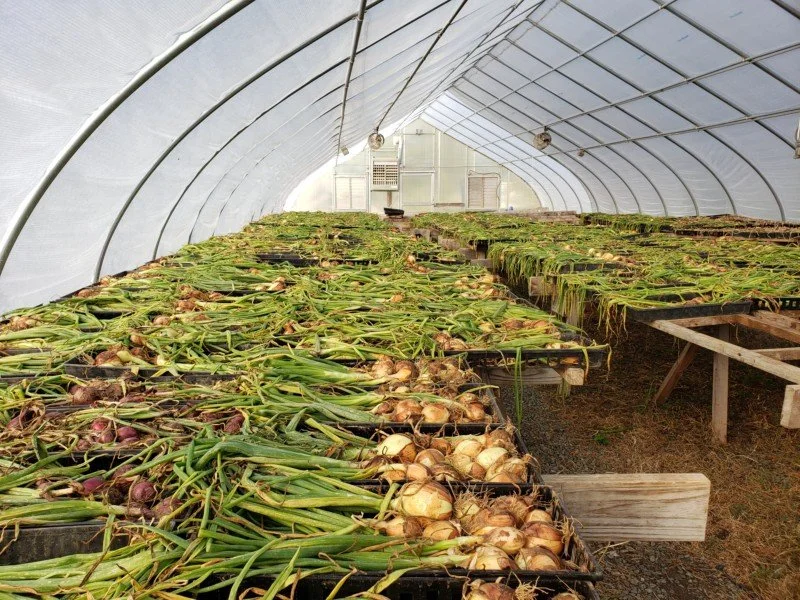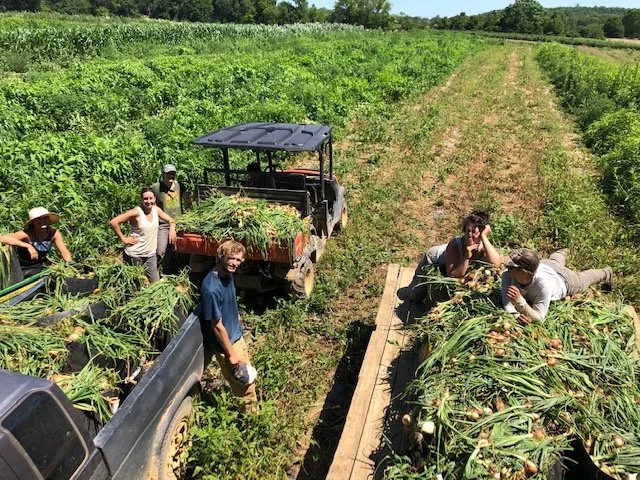Bulk Harvests and Storage Crops
Our storage onions curing in the greenhouse! We will wait until all the greens are dry before we process them for sale and CSA distribution.
Getting through a CSA season serving 500 households is no small feat! Plus we want to have plenty of extras for our wholesale and farmer's market customers. In the high summer, our fields are often dry as a bone and choked with weeds. Planting large-scale greens is pointless right now and all the ones from spring have frizzled to a crisp. Our deep summer crops like eggplant and peppers are fruiting, but not enough for large harvests. How do we get through this time and keep a variety of veggies at the market stand? Storage crops!
My feeling is that some of our customers have no idea about storage crops. However, those of you who were shopping with us deep into the 2020/2021 winter at the IX Market may remember eating some deliciously sweet carrots in January and February! Obviously, those carrots did not grow in December. They were planted in August, harvested in early October through late November and stored and sold all the way through March. That carrot crop was incredible! It served as a vital source of income for us as well as an eye-catching draw to our stall in the bleakness of winter. I'm still dreaming of that carrot crop.
But carrots are just one storage crop! And every year is different. For 2021, our spring carrots did really poorly and so we didn't have any stored away at all. However, 2021 was a banner cabbage and beet year and our storage onions are superb as well! In 2022, all the above crops did well for spring and we’re still waiting on the verdict for fall. We're busily bringing in as many of these crops as we can muster each day. The prolonged heat and (and in some years, severe dryness) will continue to deteriorate quality of all these crops. They need to be put into cold storage ASAP, where they will then store for weeks or even months, if we don't sell out before then!
Here's a bit more info on what we harvested in bulk for storage in 2021, along with photos!
Beets: Our beet crop was great for spring and the greens are dying back but the roots are still present. In fall, these roots can "field store," which means that they are fine to just hang out out there in the cool weather. However, in summer, field storage is not ideal. We need to start working on bringing these in as soon as we can, or little varmints will take a bite out of each one before we can get to them! Beet roots, like carrots, store for months in cold storage.
Cabbage: This is the big one this year! After an off-year last year, we're happy to be rolling in cabbage. On Monday, we harvested two full pallets of cabbage plus several hundred additional pounds -- probably about 2500 pounds total. The way we harvest cabbage is to cut it down the rows and pile it up in windrows. We then drive a vehicle, be it a tractor with a pallet or a trailer with buckets and then one person hands off the cabbages to someone who loads them in. Once in the barn, we wash all the cabbage that will go out immediately. We can store cabbage for up to 6 weeks for certain varieties and we can always peel the outer wrapper leaves off to reveal a shiny crisp interior. If your cabbage in your fridge gets shriveled, just peel it down!
Onions: We've gone through all our fresh-eating Ailsa Craig onions.The last of those will be available at the Meade Park Market this week. Shortly after the Ailsas peter out, our storage onion tops tend to flop over: the universal sign that they are ready to harvest. We load them up by the bucket or armload onto truck beds and trailers and transport them to the greenhouse, where we lay them out in a single layer to cure. After curing, we will process the onions so they look like the ones in the grocery store with the papery skins. Our onions are gorgeous and large this year, thanks to having them on a drip irrigation system. Look for them at markets in 2 weeks or so! Once cured, the onions will store for 3-6 weeks in dry storage.
Other storage crops: kohlrabi, turnips, garlic, carrots, and winter squash are all things with the potential to store! We're holding on to some kohlrabi and turnips from this spring, but we don't have a ton. Garlic will hit market tables in just a couple weeks. When it comes to storage crops, we just go with the flow and try to bring in whatever's in good quality and abundance.
These storage crops are our insurance policy against tougher weeks ahead. They allow us to enjoy the fruits of spring in the heat of summer! Not only that, but you, too, can store crops! If your garden overflows with beets or your CSA gives you one too many cabbages or butternuts, don't worry! You can store these crops in your own refrigerator or dry storage! In fact, many veggies improve in flavor with storage!
We still have a lot to learn about how best to manage our storage crops, but we are thankful for what we do know and the flexibility and abundance these crops provide us with.





